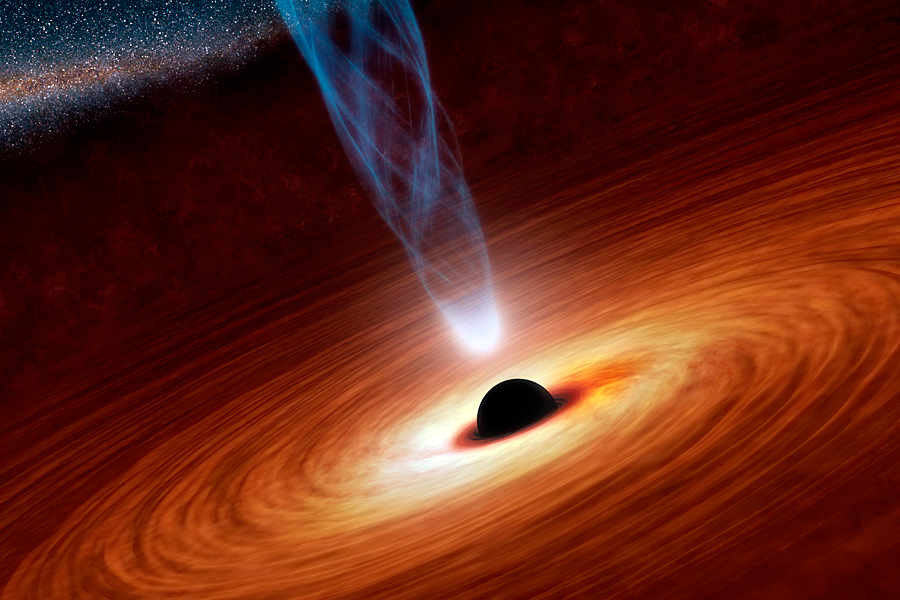Do black holes come in 'medium'? They do now.
Loading...
Like shop owners tallying T-shirts, astronomers studying black holes and the roles they play in the evolution of galaxies have small, large, and extra large objects on hand. But, until now, it's been unclear that black holes come in medium sizes.
Now, for at least one galaxy, the answer appears to be "yes." Astronomers have used syncopated pulses of radiation from an object in a galaxy known as M82 to take its measure and conclude that it is a medium-size black hole about 400 times the mass of the sun.
This is not the first time anyone has tried to measure the mass of an intermediate black hole, acknowledge the researchers conducting the analysis. But it is the most precise measurement yet made. This turns the object, known as M82 X-1, into "a compelling example of this class of black holes," says Richard Mushotzky, an astronomer at the University of Maryland.
That's not bad for a type of object that, from the standpoint of theory, appears superfluous to the black-hole story, suggests Dr. Mushotzky, a member of the team that reported the results Sunday on the journal Nature's website.
Astrophysicists have a pretty good handle on the smallest black holes, which form from the collapse and subsequent explosion of very massive stars. And they have an increasingly good handle on the super-massive behemoths of millions to billions of solar masses, which reside in the centers of the largest galaxies.
Even merely massive black holes, which range from a few hundred thousand to perhaps 1 million solar masses, have a strong constituency, even though they are probably the least understood and not as well measured as their larger and smaller cousins.
Essentially, it would seem that "there's no need for things that are a few hundred to a few hundred thousand solar masses," Mushotzky says.
More to the point, theorists have tried to simulate the creation of 400-solar-mass black holes and haven't been able to do it, he adds, so in theory, "they can't exist." But there sits M82 X-1, in effect thumbing its nose.
The observational foundation for the intermediate-black-hole puzzle was set about 30 years ago, when astronomers discovered so-called ultraluminous X-ray sources in other galaxies. Unlike the X-ray emissions associated with supermassive black holes, these ultraluminous sources were located away from the center of the galaxies in which they appeared.
Based on a well-established physical principle in which an object's mass, in effect, sets an upper limit on how luminous the object can be, these ultraluminous X-ray objects had to be one of two things, Mushotzky explains: either a black hole of several hundred solar masses, with no understanding of how such an object formed, or an object that was exceeding the limit, known as the Eddington limit.
In order to figure out which of the two explanations was correct, researchers tried to estimate the masses of these objects using a relatively straightforward approach they'd applied with success to supermassive black holes, but the approach didn't work.
In effect, consistent patterns in the data that were apparent when observing supermassive black holes, and which allowed the researchers to calculate the black hole's mass, vanished when similar observations were made from ultraluminous x-ray sources.
"Everyone scratched their head and said: We don't know what's going on," Mushotzky says.
Yet when researchers had monitored X-ray emissions from supermassive black holes, they noticed two sets of emissions that occurred simultaneously in a unique, subtle, syncopated pattern, which repeated itself. For each three peaks on one pattern, the other contained two. Moreover the number of beats making up the 3:2 pattern was directly related to the black hole's mass.
M82, also known as the Cigar Galaxy, is located some 12 million light-years from Earth. It's known as a starburst galaxy for the high rate of star formation taking place there – making it five times more luminous than the Milky Way.
M82 X-1 is the brightest ultraluminous X-ray source, so graduate student and team leader Dheeraj Pasham took up the hunt for this tell-tale pattern for M82 X-1. He gathered 800 sets of observations taken by NASA's Rossi X-Ray Timing Explorer satellite between 2004 and 2010, then devised a complex computer program to analyze the information. Mr. Pahsam is the lead author on the paper formally reporting the results in Nature.
Out jumped the pattern in the object's X-ray flares. In this case, the 3:2 pattern consisted of one flare peaking 5.1 times a second, while another peaked at 3.3 times a second.
The results give Mushotzky confidence that a different set of X-ray emissions he and a colleague reported from another galaxy in 2009 also bears witness to the presence of an intermediate black hole.
The observations could help fill a missing piece of the puzzle on galaxy formation in the early universe. Within the first 1.5 billion years after the Big Bang, galaxies already sported central supermassive black holes that were 1 billion times the sun's mass. But to conform to the Eddington limit, such black holes would have had to start with a mass of a few hundred solar masses; otherwise they "couldn't get fat enough fast enough" as they fed off of dust and stars in their galactic centers, Mushotzky says.
Acknowledging that it's highly speculative, he adds that M82 X-1 could be a relic from the very early universe and the processes that led to the growth of supermassive black holes.
A new generation of gravity-wave detectors could help hunt for an answer. The merger of two black holes is an event of such violence that it sends ripples through space-time, the very fabric of the universe. Mergers between smaller or larger black holes and an intermediate-mass black hole would set up a distinct set of ripples that in principle would be detectable by more-capable detectors.






